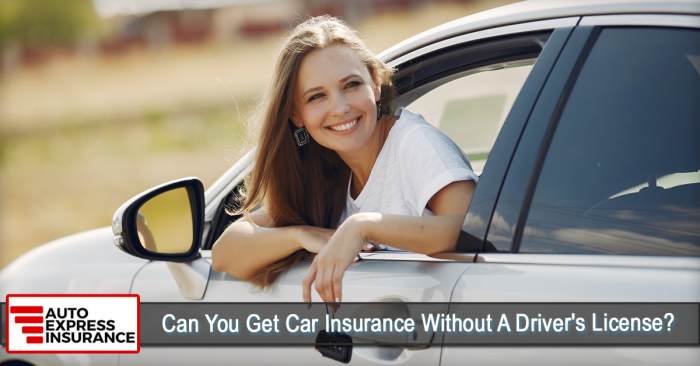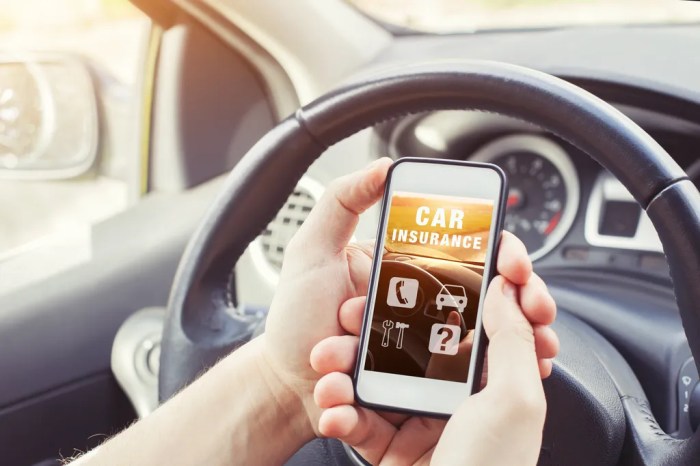Owning a car doesn’t automatically equate to driving it. Many find themselves needing car insurance despite lacking a driver’s license. Perhaps you’re a young adult awaiting your permit, someone with a disability preventing driving, or maybe you own a vehicle used solely for business purposes. This guide unravels the complexities of securing car insurance even without a driver’s license, exploring eligibility, the application process, coverage options, and legal considerations.
Understanding the nuances of car insurance in these situations is crucial. While obtaining coverage might present unique challenges, it’s often achievable with the right approach and information. We’ll navigate the steps involved, highlighting essential documentation and potential hurdles, equipping you with the knowledge to confidently pursue the insurance you need.
Eligibility for Car Insurance Without a License

It’s a common misconception that you need a driver’s license to obtain car insurance. In reality, several situations require car insurance even if you don’t possess a valid driver’s license. Understanding these scenarios is crucial for protecting yourself financially and legally.
Several circumstances may necessitate car insurance despite lacking a driver’s license. This often involves situations where you own a vehicle but either cannot or choose not to drive it, or if the vehicle is driven by others. The type of insurance policy needed will vary depending on the specific circumstances.
Types of Car Insurance Policies and Applicability
Several types of car insurance policies exist, each offering different levels of coverage. While comprehensive and collision coverage are most often associated with licensed drivers, other policies are relevant to unlicensed vehicle owners. Liability insurance, for instance, is crucial regardless of driving status, protecting you from financial responsibility for damages or injuries caused by your vehicle, even if someone else is driving it. Uninsured/underinsured motorist coverage protects you if you’re involved in an accident caused by an uninsured or underinsured driver. These types of coverage are particularly relevant for those who own a vehicle but don’t drive it themselves.
Situations Requiring Car Insurance Without a License
Owning a vehicle, regardless of whether you drive it, often mandates insurance. Many states require proof of insurance for all registered vehicles, regardless of the owner’s driving status. This is because a parked car can still be involved in an accident (e.g., a tree falling on it), and liability coverage protects you from potential claims. Similarly, if you allow others to drive your vehicle, you need liability insurance to cover their potential accidents. Even garaging a vehicle might necessitate insurance, as some insurance companies and state laws require coverage for stored vehicles. For example, a person who owns a classic car and stores it in a garage might still need insurance to cover potential damage from fire or theft.
Coverage Options: Licensed vs. Unlicensed Individuals
Licensed drivers typically have access to a broader range of insurance options, including comprehensive and collision coverage which protect their own vehicle from damage. Unlicensed individuals, however, may find their options more limited, primarily focusing on liability coverage. The cost of insurance may also vary; unlicensed individuals might pay less for liability-only coverage, but they will lack the protection afforded by comprehensive and collision coverage. This difference reflects the lower risk associated with a vehicle not being actively driven by the owner. For instance, a licensed driver might pay a higher premium for full coverage, while an unlicensed owner might pay a lower premium for liability-only coverage on a vehicle they do not drive.
Legal and Regulatory Aspects

Owning a car, even without a driver’s license, involves significant legal responsibilities, primarily concerning insurance. While you may not be legally permitted to *drive* the vehicle without a license, you are still required to maintain adequate insurance coverage, depending on your state’s regulations. Failure to do so can result in severe penalties.
The legal requirements for car insurance are fundamentally tied to vehicle ownership. Most jurisdictions mandate minimum levels of liability insurance, regardless of whether the owner possesses a driver’s license. This insurance protects others from financial harm should an accident occur involving your vehicle, even if someone else was driving it. The specific requirements, however, vary significantly depending on the location.
Minimum Liability Insurance Requirements
State laws dictate minimum liability insurance coverage, typically expressed as limits for bodily injury and property damage. For example, a state might require 25/50/25 coverage, meaning $25,000 per person for bodily injury, $50,000 total for bodily injury in an accident, and $25,000 for property damage. These limits are the minimum amounts an insurer will pay in the event of an accident you cause. Failing to meet these minimum requirements is a serious offense, punishable by fines, license suspension (even if you don’t have one), and potential legal action if you cause an accident. Some states also mandate uninsured/underinsured motorist coverage, protecting you in case you’re involved in an accident with an uninsured driver.
Consequences of Driving Without a License and/or Insurance
Driving without a valid license is a serious offense, carrying penalties that can include hefty fines, license suspension or revocation, points added to your driving record (if you later obtain a license), and even jail time in some cases. Driving without insurance exacerbates the situation, potentially leading to much higher fines and more severe penalties. If you cause an accident while uninsured and unlicensed, you could face civil lawsuits from injured parties, potentially leading to significant financial liability.
Examples of Legal Ramifications
Scenario 1: John owns a car but lacks a driver’s license. He allows his friend, Mary, to drive it, and she causes an accident, injuring another driver. Because John didn’t have the required insurance, he faces significant legal and financial consequences, including potential lawsuits from the injured party and penalties for not having insurance. Even though he wasn’t driving, he is still responsible for ensuring his vehicle is properly insured.
Scenario 2: Sarah owns a car and has the minimum required liability insurance. However, she drives it without a license. If she causes an accident, she will face penalties for driving without a license, and while her insurance will cover damages to other parties, her own insurance policy might be voided depending on the specifics of the policy and the state’s laws.
State-Specific Variations in Legal Requirements
The specific legal requirements regarding car insurance and driving without a license differ significantly between states. Some states have stricter penalties for driving without a license than others. Similarly, the minimum liability insurance requirements vary considerably. For example, some states might mandate higher coverage limits than others, or include additional mandatory coverages. It’s crucial to check your state’s Department of Motor Vehicles (DMV) website or consult a legal professional to understand the precise legal obligations in your specific location.
Illustrative Scenarios
Understanding the nuances of car insurance without a license requires examining various real-world situations. The following scenarios illustrate how different individuals and circumstances necessitate insurance coverage even in the absence of a driver’s license.
Scenario: The Unlicensed Young Adult
Sarah, a 17-year-old, recently received a car as a gift from her grandparents. While she is diligently studying for her driving test, she is not yet licensed. Her parents are understandably concerned about liability if Sarah’s car were to be involved in an accident, even if she’s not driving. They seek insurance to protect themselves and their assets from potential claims should someone else be driving the car with Sarah’s permission, or if the vehicle is damaged while parked. A comprehensive policy, including liability and collision coverage, would provide the necessary protection. This coverage would ensure that in the event of an accident or damage, the financial burden wouldn’t fall solely on the family.
Scenario: The Permanently Disabled Driver
John, a 50-year-old, was involved in an accident that left him permanently unable to drive. He still owns his car, which is modified for accessibility and is primarily used for storage and occasional transportation by family members. He needs liability insurance to protect himself financially if someone driving his car with his permission were to cause an accident. While he doesn’t drive, the risk of accidents involving his vehicle remains. Liability insurance is crucial to safeguard his assets in such a scenario.
Scenario: The Classic Car Enthusiast
Mark, a 60-year-old retiree, owns a classic car that he rarely drives. He participates in occasional car shows and enjoys maintaining the vehicle. Although he doesn’t drive it regularly, he still needs insurance. A specialized classic car insurance policy, often offering agreed value coverage, protects the car’s value, which might exceed its market value due to its condition and rarity. This coverage is vital to protect against theft, vandalism, or damage during transport to and from events.
Scenario: The Business Vehicle Owner
A small delivery company owns several vans used for business purposes. While the company employs licensed drivers, they might still need insurance on the vans even when they are not in operation. This comprehensive coverage would protect against damage, theft, or liability issues when the vans are parked or being serviced, ensuring business continuity in case of unforeseen events. The insurance would cover potential damages caused by the vehicle, even if it is not being actively driven.
Final Thoughts

Securing car insurance without a driver’s license is achievable, though it requires a nuanced understanding of policy types and legal obligations. While the process might differ from standard insurance applications, the potential benefits – protecting your asset and fulfilling legal requirements – are substantial. By carefully considering your individual circumstances and navigating the steps Artikeld, you can find the appropriate coverage to safeguard your interests.
FAQ Compilation
What type of insurance is best for an unlicensed car owner?
Liability-only coverage is often sufficient for unlicensed owners who don’t intend to drive the vehicle. This protects against financial responsibility for accidents caused by others using your car.
Can I insure a car I don’t drive?
Yes, you can. Many insurance companies offer policies for vehicles not regularly driven, often at lower premiums. The specific policy details will depend on your situation and the insurer.
How much will insurance cost without a license?
Premiums vary widely based on factors like vehicle type, location, age of the vehicle, and the type of coverage selected. Generally, liability-only coverage will be cheaper than comprehensive or collision coverage.
Will my insurance rates increase if I later get a license?
Possibly. Your insurer may re-evaluate your risk profile once you obtain a license, which could result in a premium adjustment. It’s advisable to inform your insurer of any changes in your driving status.